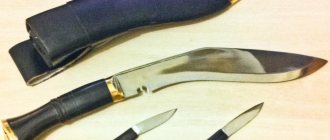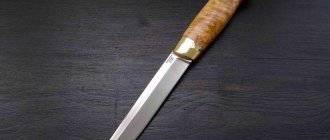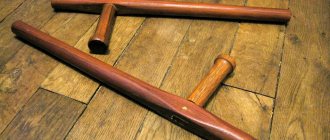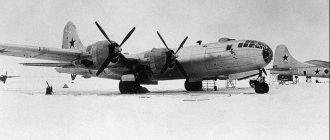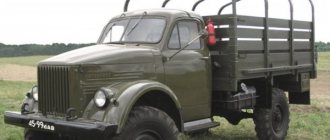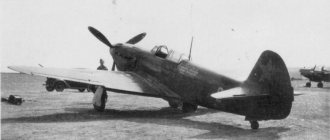The Cherry knife is a legendary army weapon with a Bowie blade, a stopper and a simple barrel-shaped plastic handle. Its full size is 266-280 mm, the steel part reaches a length of 150-160 mm, the guard is flat, and the weight is up to 150 g. Therefore, the weapon can also be used as a throwing weapon.
A real “Cherry” with a mark in the form of a capital letter P on the base of the blade belongs to a bladed weapon, it is difficult to buy. But the companies A&R, Knox, Vityaz, Russian Bulat, Zlatko have models of knives with the same name. You can purchase them freely at prices starting from 1.5 thousand rubles. up to 13.2 thousand rubles
How the “Cherry” knife appeared according to official sources
There is a version that the Cherry knife appeared in 1943, after the improvement of the HP-40 edged weapon. The latter was used by scouts in front-line conditions and caused many complaints due to the wooden handle swelling from water and the uncomfortable s-shaped guard, which made everyday work difficult with a direct grip.
It was urgent to create a knife for the military that would meet their requirements, because it could save many lives. This was done, and a weapon with a less vulnerable plastic handle and a modified shank was born.
1 of 2
Finca
We deliberately did not add the abbreviation NKVD in the title; after all, the Finnish puukko knife or “finka” existed before our finka was adopted. But first things first.
Finka NKVD
Source: pinterest.ru
During the turbulent years of the revolution and the Civil War, the population accumulated millions of different knives, but the Finnish knives came into common use. On the one hand, it was perceived as a knife used by “criminal elements.” On the other hand, the word “finca” itself in the USSR in the 30s was often used instead of the usual “knife”, and the object itself might not have any resemblance to the original model. The appearance of the “Finnish NKVD” coincided with the tightening of USSR legislation regarding the circulation of civilian edged weapons in the first half of the 30s.
Finka NKVD
Source: pinterest.ru
At the same time, NKVD employees began to receive new knives as clothing allowance (!) during these years as part of their supply. The knife was a slightly modified version of the Finnish puukko type knife: a straight spine, with a small “pike” and a characteristic handle head. A guard was added to the prototype knife; most often it was S-shaped, but sometimes one-sided or C-shaped guards were found. This knife, excluding rifle bayonets, became the first standard knife in Soviet law enforcement agencies and paved the way for its successors.
Where is the truth about the knife “Cherry” HP 43
According to the official version, the Cherry knife NR 43 was produced by the ZIK plant in Zlatoust. But it is clear that there are no documents at the enterprise that weapons were actually produced there. Additionally, the plastic used for the handle was rare in 1943. It can only be seen on general or award weapons. And they worked with the material manually, which made serial production of the HP 43 in 1943 unrealistic.
But there is documented information about how during the war the ZIK was designing a new type of army knife. The models were indeed made, but in small quantities, they did not reach us. But it most definitely was not the popular HP 43.
Combat knives
The most ancient weapon is the combat knife, which, in principle, became the founder of all types of edged weapons. It’s hard to say what he looked like, but something like this:
Millennia have passed, but the knife, even in the modern atomic age, has remained in service with all armies of the world. Of course, it has undergone huge changes. Dozens of all kinds of these weapons appeared for various branches of the military. The most famous was the Buck M9 MB used in the American army, a standard bayonet for the M16 assault rifle, released in 1973. Total length 350 mm. Blade length 200 mm, weight 370 g. Still in service. The latest modifications M9232 and M9235 have an anti-reflective and anti-corrosion plasma-ceramic coating. Removable handle, saw and, together with the sheath, wire cutters.
The Russian analogue is a bayonet for a Kalashnikov assault rifle. Total length 315 mm, blade length 205 mm. weight 340 g. Removed from service, but available in large quantities in long-term storage warehouses. Its new modifications are still in service.
During the Second World War, detachments of underwater saboteurs were organized in Italy, which turned out to be very effective. Since then, combat swimmers have appeared in all countries of the world. Their armament could not do without edged weapons. This is what the combat knife of modern Italian combat swimmers looks like.
The combat knife of the Marines is of particular importance. The Russian Marine Corps is armed with a “Storm” knife specially designed for this purpose. It is made of stainless steel, has an impact-resistant handle, and is designed for close combat.
The so-called tactical knives can be divided into a separate group. Their peculiarity is that they combine the properties of combat and utility knives and therefore have a very wide range of purposes.
Throwing
Among the various types of bladed weapons, knives used to kill with a throw, the so-called throwing knives, stand out. In special units of the Russian troops, such knives have been used since the Finnish War. The throwing knife is distinguished by a special design in which a certain weight balance is maintained, ensuring that when throwing, it hits the target with the tip of the blade. The steel is very hard but not brittle, so that when it hits hard objects the tip does not get chipped. Now there is even a separate sport - knife throwing. For this purpose, specially designed samples are produced.
Plausible versions of the appearance of the scout knife “Cherry” from alternative sources
There is also information that the “Cherry” scout knife was created in the 70-80s of the last century from old HP 40 blades. The latter allegedly lay in the ZIK warehouse for a long time, although the company’s management denies the presence of unaccounted for bladed weapon parts. It is quite possible that items with old marks were stored in military warehouses.
The handles, which had deteriorated over time, were replaced with plastic ones, the design was supplemented with an even guard, and the result was “Cherry”. But everything was done not at ZIK, but at other enterprises. This version looks less romantic, but more like the truth.
The guns were received by paratroopers, including those who took part in the war in Afghanistan. They are only pictured from the 90s, but there is oral evidence of combat knives from an earlier period.
We recommend reading about the characteristic features of the scout knife. From the article you will learn about the characteristics of a scout knife, its application, popular types, and cost. And here is more information about the best hunting knives.
History of creation
One of the variants of the “NKVD Finnish”. , 1930s.
In the early to mid-1930s, legislation regarding the circulation of bladed weapons was tightened in the RSFSR; a direct ban on the manufacture, storage, sale and carrying of Finnish knives appeared in the Criminal Code. At the same time, NKVD employees have been receiving, as a special tool, since 1935 a Finnish knife (in some documents a “Norwegian” or “Swedish type knife”), manufactured in several varieties (formerly a factory of the industrialist Kondratov) in the village of Vacha, Nizhny Novgorod region. The basis of the “NKVD knife” was a copy of a Swedish knife produced by P. Holmberg, which was banned as a “Finnish knife.” The knife was characterized by either a straight spine or a spine with a characteristic bevel - “pike”, fullers, and a Finnish type of handle head. A distinctive feature from the Finnish puukko was the developed curved, often S-shaped. An unsharpened heel was left on the blade in front of the guard, so that in some grips the index finger could be transferred to the blade. The handle was made of carbolite. The knife was not officially in service, but was issued as clothing allowance. From the 1930s to the end of the 1970s, he completed at least 6 large orders for similar knives.
The Soviet-Finnish War revealed shortcomings in the Red Army's armament. Among other conclusions, in 1940 the models of authorized edged weapons were revised, in particular, a new army knife was adopted for service.
The alleged prototypes of the Soviet army knife are:
- Finnish uniform bayonet-knife of the 1919 model, designed by the artist Akseli Gallen-Kallela and produced by Fiskars - an eclectic model combining a blade with a lower spine line, fullers and a developed heel, a large S-shaped guard, a saber handle with a metal back, an all-metal sheath, repeating the curve of the puukko sheath, a large lanyard brush, borrowed from long-bladed weapons;
- Finnish scout knives (partiopuukko) - knives designed for boy scout organizations in different countries, with clear signs of American traditions - a double-sided (less often one-sided) guard stop, a blade with a predominantly beveled spine, a narrow or wide fuller. Scout models, purchased with personal funds, enjoyed some popularity among soldiers of the regular Finnish army and representatives of volunteer organizations.
None of the models can be called the direct ancestor of the HP-40, although all elements of the knife, design and manufacturing technology are easily recognizable in the prototypes.
Characteristics and dimensions of the “Cherry” knife, model 1943
The “Cherry” scout knife, model 1943, is distinguished by a blade with a “pike nose” type tip, a smooth blade, a rather thin spine and a handle that is shorter in length than the cutting part. It is a little similar to the HP 40. But the HP 43 has a wider blade, a symmetrical handle, and a straight and flat guard, not an S-shaped one.
The dimensions of the Cherry knife are as follows:
| Characteristic | Meaning |
| Blade type | Bowie |
| Blade length | 158 mm |
| Blade width | 22 mm |
| Butt thickness | 2.4-3 mm |
| Handle material | Plastic |
| Handle shape | Barrel-shaped |
| Handle length | 112 mm |
| Handle width | 30 mm at its thickest point |
| Weapon weight | 150 g |
The lightness of the “Cherry” allows it to be used not only for inflicting piercing and cutting blows on the enemy, in everyday life and on the road, but also as a throwing weapon. The instrument is well balanced, fits comfortably in the hand, and is almost universal.
Handle
The weapon handle is 112 mm long, 30 mm wide, made of plastic and comes in:
- bright green (most often);
- white or black (less common);
- gray or steel (the most unique option).
It has a barrel-shaped shape, tapering towards the junction with the guard and towards the heel. The surface of the part is corrugated, which makes it easier to hold the tool during active use.
Blade
The fixed blade HP 43 has a length of 158 mm, a width of 22 mm and has the following features:
- smoothly beveled butt 2.4-3 mm thick;
- more strongly raised blade;
- concave slopes starting in the upper third of the blade;
- the presence of a capital letter P at the base, similar to a cherry hanging on the stalk.
The blade is of the “Bowie” type. At the same time, its shank passes through the handle completely, that is, the fastening of both parts is reliable. The blade is separated from the handle by an elongated hexagonal or rounded guard.
Damascus-type steel is used to create “Cherry” only in our time; these are produced, for example, by the Russian Bulat company. Older weapons have softer blade material, but also of high quality.
Replica from Chrysostom
On the market, the original wartime HP-43 “Cherry” costs a lot of money, and quite respectable collectors are “hunting” for such examples. But despite this, the Zlatoust replica of the HP-43 reconnaissance knife is an inexpensive and high-quality alternative to the original version.
It is clear that the replica is made for amateurs, but has an almost identical appearance and characteristics to those of a real combat edged weapon.
The Zlatoust Arms Factory can reproduce the HP-43 knife quite accurately. The only difference is the steel from which the blade is made. And special minor modifications to take the knife out of the realm of edged weapons for sale on the civilian market. And all of the above parameters, blade length, width, butt thickness, etc., remain unchanged.
Thus, the Zlatoust replica “Cherry” is similar to a real combat blade and complies with all GOST standards and fits under the section “Tourist and special sports knives.”
Previous
Kitchen knivesProper cutting of jamon with a knife
Next
Combat knivesFinnish NKVD knife: history, dimensions, drawing
Price for knife “Cherry”
The price of a product offered for free sale can be 1.6 thousand rubles or 12 thousand rubles, and for weapons with interchangeable blades it reaches 30 thousand rubles. The most affordable tools in this sense are tools from the Vityaz company. True, these are small knives with a blade only 146 mm long, made of 65x13 steel. Products from Knox and Titov and Soldatov fall into the same price category.
The middle segment - knives from A&R and Zlatko companies at a cost of 3.8-4.7 thousand rubles. The most expensive products from Russian damask steel are at least 6 thousand rubles. for the simplest example. All of them belong to the hunting or collection type and do not fall under the definition of “edged weapons” or combat weapons.
Watch in this video the history of the creation and cost of the Cherry knife:
Delivery
Post office
A valuable parcel with a pre-paid product, or a valuable parcel with cash on delivery.
Delivery costs depend on the destination and are calculated automatically during checkout. Calculations from the Universal Calculator of Russian Post and EMS are used. When choosing the “Cash on Delivery” payment method, payment is made upon receipt of the order at your post office. When the order is delivered to the post office, a notification will be sent to the address you specified, and we, in turn, will notify you by phone. Be careful, the post office charges the recipient a commission of 5-8% for transferring the payment. To receive your order you must have your passport with you.
Courier service SDEK
Fast delivery throughout the Russian Federation and the CIS. Delivery is possible to the pick-up point, as well as to the door. Delivery costs depend on the destination and are calculated automatically during checkout. You can check the delivery cost by calling us by phone.
*Attention!
Delivery of TC SDEK throughout Russia and the CIS countries (Armenia, Belarus, Kazakhstan, Kyrgyzstan) is carried out only after payment for the order.
After placing an order, a manager will contact you by phone within 12 hours from the date of order. Please provide valid phone numbers and stay in touch.
Knife manufacturers and product features
There are several popular manufacturers who are developing the Cherry knife. Although the weapons are approximately the same, each has its own characteristics and distinctive characteristics.
A&R
The “Cherry” knife from AiR is made of 95×18 stainless steel, high-alloy. Therefore, the hardness of its blade is 58-59 HRC. The shape of the blade and handle are classic for this type of weapon. Its total length is 266 mm, and the working part is 150 mm. The handle material is quartoprene, and it is green in color and grooved. The thickness of the butt is 2.4 mm. These parameters make the product available to everyone without a permit for edged weapons. Its minimum price is 3.8 thousand rubles.
Knife “Cherry” from Air
Zlatoust
The product from the city of Zlatoust from the Zlatko company is distinguished by its large dimensions:
- blade – 160 mm,
- its width is 24 mm,
- total length – 280 mm,
- The maximum thickness of the butt is 2.4 mm.
It is forged from steel grade 100x13, that is, it has a sharp blade with a hardness of 56-58 HRC, which retains its sharpness for a long time and is not afraid of water and aggressive chemicals. Hence the cost of the gun - from 4.7 thousand rubles. It also does not belong to the category of edged weapons.
Watch in this video a review of the “Cherry” knife from the Zlatoust company:
Knox
The Knox company has created a product with different proportions than classic weapons:
- the blade has a length of 147 cm;
- its thickness is 2.3 mm;
- total size – 260 mm.
Knife “Cherry” from Knox
The handle of the product is black, plastic. The blade steel grade is Japanese AUS-8, which allows you to keep the blade sharp for up to 3 months of active use. In addition, it is quite durable. Disadvantage: it rusts easily from water. Therefore, the price is modest - from 2 thousand rubles. on the company's official website.
Russian damask steel
The Russian Bulat company has several products called HP 43:
- Collapsible with a blade made of U8 steel. It has standard dimensions: the cutting part is 152 mm, the total length is 262 mm, the thickness of the black plastic handle is 30 mm. The quality of the steel makes the tool sharp, holds an edge for a long time and is durable under any type of load. Therefore, its price is 7 thousand rubles.
- Non-separable, with a 65×13 steel blade and a green handle. The dimensions of the component parts of the product are the same as the previous one. But the blade material is cheaper, the quality is slightly lower, so the price is 6 thousand rubles.
- Collapsible with Damascus steel blade. The numerical parameters of this tool are the same as the previous ones. Externally, it differs only in the green handle, but it is also made of plastic. Cost up to 8.2 thousand rubles. increases the quality of blade steel. It is sharper since the hardness of the material is 60-64 HRC.
- Non-separable with a blade made of ELMAX powder steel with a hardness of 60-64 HRC, a green plastic handle. Its dimensions correspond to previous products. But powder steel gives the tool higher strength, wear resistance and corrosion resistance. Therefore, it costs 13.2 thousand rubles.
Knife “Cherry” from Russian Damask Steel, collapsible model
The Russian Damascus Steel line also includes “Cherry” products with interchangeable blades, including different sizes, costing 12-30 thousand rubles. depending on their quantity and quality of steel. There are also knives in the “Fisherman-Hunter”, “Fighter”, “Fisherman-Tourist” configurations at a price of 12 thousand rubles. each.
With hornbeam handle
The weapon, for which a hornbeam was used in the manufacture of the handle, is produced by the AiR company from Zlatoust. The product has traditional dimensions and proportions of parts; the blade is made of 100×13 steel. The pommel of the handle is metal, but the handle itself is black. The cost of such a knife is 5.5 thousand rubles.
There is also a cheaper product with a handle made of carved hornbeam from a lesser known one. Its blade is only 155 mm and is made of 65G steel. The characteristics of the material are such that the knife is easily damaged under impact load. But since the blade is small, this drawback does not appear so much. Therefore, the price of the product is 2.6 thousand rubles.
DIY knife “Cherry”
Do-it-yourself HP 43 is made in several stages:
- First, prepare a drawing of the blade and handle on paper. It is important to observe all dimensions, bevel angles, and roundings. The length of the blade shank should correspond to the size of the handle.
- Then a blade blank with a shank is cut from a piece of steel of suitable quality. This is done with a grinder, clamping the plate with clamps. To remove the formed burrs, the workpiece is processed on a grinding machine.
- Next they make descents on the blade. You need to retreat 10-11 mm from the heel, measure half the width of the blade and remove excess metal using a grinder with a grinding attachment. All that remains is to process the slopes with a belt sander, a file and sandpaper.
- Now the blade should be hardened. This is done in a forge, heating it until it glows yellow if carbon steel is used, and cooling it in oil. Hardening is considered to have been carried out correctly when, after it, the metal does not respond to the effects of a file.
- The next stage is steel tempering to increase its ductility. That is, the blade is heated to 220-250 degrees, kept there for an hour and allowed to cool slowly. The procedure can be performed using an oven. The workpiece is not removed from there until it cools down.
- A guard approximately 2-2.5 mm thick is cut out of a steel plate. It's easier to make it oval. The central hole in the guard should match the width of the shank, that is, it goes right through, but does not dangle in it.
- It is necessary to make a metal frame for the handle, which will separate the guard from the wooden part of the handle. It requires a sheet of steel 10 mm thick so that the wall size is 3 mm.
- The handle is made from hornbeam, this is the simplest and does not deprive the knife of its originality. It must be solid, not made from component parts, cut out according to a sketch. Inside the black hornbeam block, a drill makes a longitudinal hole corresponding in thickness to the shank. External surfaces are brought into the appropriate form using a machine, file, or grinder.
- The weapon is being assembled. The guard must be placed on the tang to the base of the blade. Then a fitting is attached to the wooden part of the handle. The blade is attached to the handle by threading its shank through the hole in the fitting. A nut is attached to the narrow tip protruding from the other end of the handle. It should go through its entire depth, but not protrude too much.
You can make a handle for a knife from cherry yourself in the same way as from hornbeam. You need to take a knot that matches the thickness of the blade and mark the center on the cut. Next, a hole is drilled in it, running along the entire length of the workpiece. A shank with a metal handle already attached to it is inserted into it. A nut is screwed onto the tip of the part, looking out from the other side of the wooden piece.
Now the future handle can be given the desired shape. It is clamped in a vice, processed with a file, on a machine, and planed with another knife. The almost finished handle is polished until smooth. All that remains is to soak it in linseed oil, immerse it in it for 2 days and seal it tightly, and then air dry it for the same time.
We recommend reading about the coolest knives known throughout the world. From the article you will learn about the sharpest, most dangerous and beautiful knives, the ranking of the best knives in the world, the highest quality and most popular in Russia. And here is more information about the types of combat knives.
“Cherry” is a knife with a legend. But it is very difficult to buy a real one, that is, one that is in service with the Russian army; moreover, you will need permission to own it and a lot of money for the acquisition. But it’s easy to get a replica of a weapon, which will be useful in the forest, fishing, at home and will simply become one of the decorations of the collection.
Knife fighting methods used in reconnaissance
Various historical sources unanimously claim that every intelligence officer of that time was an excellent master of knife fighting. In fact, in reconnaissance it was permissible to use a knife for a surprise attack or to kill an enemy who was temporarily distracted; based on this, the scouts were trained in two types of knife grips and a couple of classic strikes.
The first method is a regular straight grip, in which the hand tightly squeezes the handle while holding the knife with the blade up. This position made it possible to deliver a strong blow to the enemy in the stomach or under the ribs. The drawback of this grip was the excessive stiffness of the hand and the inability to gain good speed.
The second method was the reverse grip, which was what soldiers often used; the blow was delivered with one hand from top to bottom, and the second scout could cover the enemy’s mouth so that he did not have time to call someone for help.

